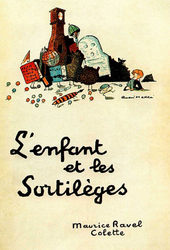L'enfant et les sortilèges
| Work data | |
|---|---|
| Title: | The child and the magic spook |
| Original title: | L'enfant et les sortilèges |
| Original language: | French |
| Music: | Maurice Ravel |
| Libretto : | Colette |
| Literary source: | Colette: Divertissement pour ma fille |
| Premiere: | March 21, 1925 |
| Place of premiere: | Opéra de Monte-Carlo |
| Playing time: | approx. 45 min |
| Place and time of the action: | Room and garden of a country house in Normandy |
| people | |
|
|

L'enfant et les sortilèges (German: Das Kind und der Zauberspuk ) is an opera by Maurice Ravel , which was completed in 1924 and premiered in 1925. Sidonie-Gabrielle Colette wrote the libretto .
action
First part
A child sits sullenly at a desk. It doesn't feel like doing its homework. When his mother asks about the progress of the work, the child sticks out her tongue without further ado. The mother is horrified: "You stay alone until dinner and think about your mother's grief!" The door closes. The child is gripped by a limitless rage. Its destructive anger is directed against the adult world that surrounds it. In a violent surge it devastates its room and mercilessly torments its pets. The blind aggression is followed by the triumphant cry: "I am evil and free!".
Second part
After that there is silence, just for a moment. Because suddenly miraculous things happen: One after the other, the objects in the room come to life: furniture, clock, cup, teapot, fire, shepherds from the wallpaper, open fire, math teachers and cats accuse the child and harass them. Then the walls of the house disappear. The child finds himself relieved in the garden. But the nightmare continues: frogs, dragonflies, bats and other animals accuse the child, attack them, and finally begin to tear each other apart. A squirrel is thrown out of the crowd of fighting animals. The child spontaneously binds the animal's paw. The other animals freeze and fall silent. The spook is over. The piece ends with a transfiguring fugue: “It is good, the child, it is 'say'” (French for “good” and “wise”), the animals sing soothingly and lead the child back to their mother.
Emergence
Colette and Maurice Ravel met in 1900 in the salon of Marguerite de Saint Marceaux, which was also frequented by Claude Debussy and Gabriel Fauré . Colette perceived Ravel as distant and dry. It was not until 1914 that Colette was asked by Jacques Rouché , who was director of the Paris Opera, to write a draft for a fairy ballet. Rouché was enthusiastic about her short prose sketch, which she drew up in eight days. He suggested Maurice Ravel as composer, but at the same time pointed out that the compositional work could take longer. Ravel accepted the libretto, but then took part in the First World War in 1916 near Verdun . When Ravel's mother died in 1917 and set the mood for Le tombeau de Couperin , he approached Colette's drafts again and completed the opera in 1924. The first performance took place a year later at the Opéra de Monte Carlo.
shape
L'enfant et les sortilèges is a thoroughly composed opera in which individual numbers are linked by interludes.
|
First part
|
Second part
|
There is an English and a German singable translation. One of the German translations by Stephan Göritz was premiered on February 25, 2001 in the Berlin Konzerthaus on Gendarmenmarkt with Gert Westphal as the narrator.